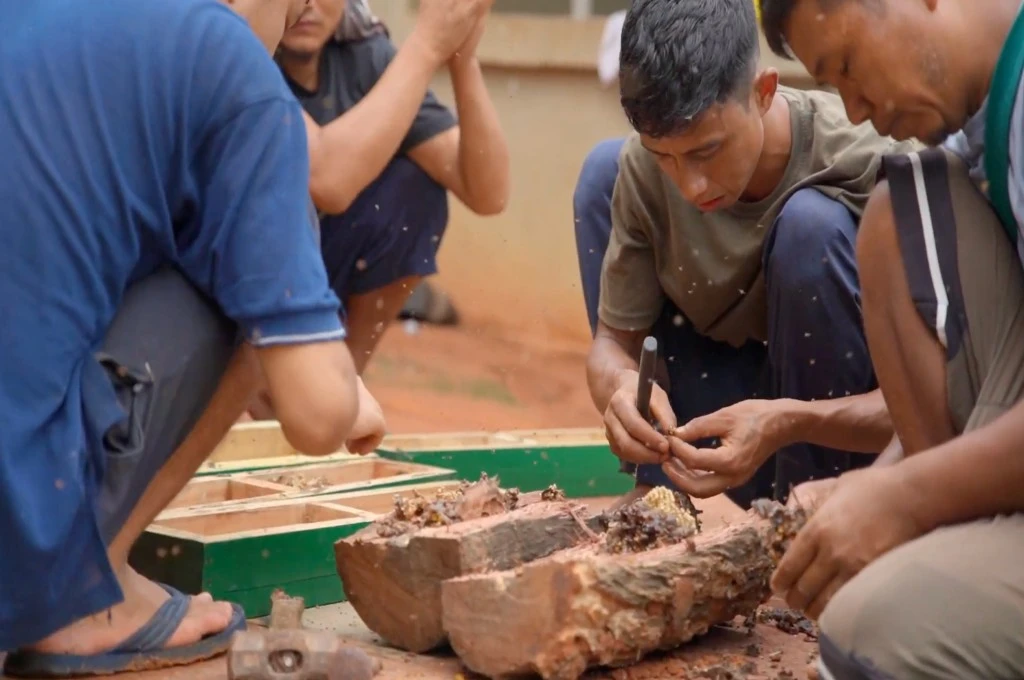On entering the town of Shahjahanpur in Meerut district of Uttar Pradesh, one can spot large plant nurseries on either side of the road. Inside these nurseries, labourers can be seen working on the plants and watering them. Owning a plant nursery is a profitable business, but the workers who keep these nurseries operational can barely make ends meet.
There is a gendered division of labour within these nurseries. A female nursery worker sweeps the nurseries, removes dry leaves from plants, and adds soil to the smaller ones. They also occasionally spray pesticides on the plants. They are paid INR 250 a day, approximately half of what the male labourers are paid. The male labourers engage with customers, lift and unload heavy plants, and load materials on to trucks, which takes a heavy toll on their bodies. They make INR 400–500 a day for this work.
Although the women labourers are just as knowledgeable about the plants in the nurseries, the men are tasked with interacting with customers due to societal norms that discourage women from talking to men outside their families. As a result, women’s labour often remains unseen or undervalued.

Sonam, a 30-year-old nursery worker, leaves her home after cooking the day’s meal. Her husband too is a nursery labourer. Neeraj, also in her thirties, works to support her family. Both Sonam and Neeraj started working after getting married as their financial struggles worsened. “Our parents never expected us to work, but we started working after getting married because we were asked to by our in-laws and husbands,” Neeraj shares.
A mother of two kids, Sonam notes that INR 250 a day is not much, but it lets her add to the family’s income. “On some days we get work, and on others, when no one calls us for work, we have to stay at home. The income is not stable,” Sonam says. Most of the women labourers come in to work in the morning after completing their domestic and childcare responsibilities. Even when they go back home after work, they have additional domestic tasks to complete.
Sonam and Neeraj share that they are from different castes but became friends while working together in nurseries. Although it was traditionally the occupation of people from the maali caste, the job is now done by people from different castes and religions. This is primarily due to the expansion of nurseries and the lack of alternative occupational opportunities in Shahjahanpur and its surrounding areas.

Despite the work requiring significant physical effort, the women labourers report that they are wary of taking a day off when they menstruate. “For us even INR 250 matters a lot, so we work despite the pain,” they replied. Some labourers are hired by these nurseries on a monthly basis. While this offers them a sense of stability, their earnings are still fairly low.
Now 35 years old, Mujahid Khan has been a nursery worker since he was eight. He was raised by a single mother who struggled financially, so there were often delays in the payment of his school fees. When this happened, he would be scolded by the school administration. The humiliation he felt led to him dropping out of school and taking up work as a nursery labourer. He says, “At least working was better than getting scolded and being embarrassed for not paying the fees on time.” Mujahid wants his children to be able to study and not end up as labourers. “We had no choice, but they do. This work is exhausting, and there is not much scope for growth,” he adds.

Anil Saini, a nursery worker in his thirties, lives in Shahjahanpur with his diabetic wife. She has to travel to Meerut for treatment every month, which requires Anil to take a day off from work to accompany her.
The workers who load, apply, and transport fertilisers are also at risk of exposure to harmful chemicals that are sprayed on the plants. They are not provided with safety equipment such as masks or gloves while working. Those who wear such equipment have bought it themselves. When the labourers do fall ill, they often continue coming into work as they cannot afford to lose out on their wages for the day. As Anil toils away despite having a fever, he remarks, “I don’t have the luxury to miss work. I already have to take the day off when I travel to Meerut with my wife for her medical appointments. I’ll just go to the doctor in the evening if I can and procure medicines to treat my symptoms.”

Investing most of his earnings into his children’s education, Anil hopes to help them build a better life for themselves. However, he laments the quality of education in local government schools. Anil reports that he personally visited the school his children study at and requested the teachers to give them homework so that they can practise what they’ve learned. However, they denied his request.
Anil mentions that the lack of a union for the unorganised labour force leaves them without a platform to voice their demands and learn about their rights. Moreover, the labourers do not have access to information about relevant government schemes or programmes that could benefit them. According to Anil, most of the labourers working in nurseries do not have e-Shram cards, which is an identity card for unorganised workers that helps them avail the benefits of welfare schemes. He cites their lack of awareness regarding the initiative and the confusing and complicated application process as the primary reasons for this.

Anil notes that he’s been to the government office on numerous occasions and taken the help of the staff to fill out forms, even paying an application fees for the same. “An official once told me that there was a Below Poverty Line scheme that would allow my family to receive some money from the government. I applied for the scheme and even paid a small sum for it. But I never heard back from them.”
The nursery workers in Shahjahanpur are subjected to low wages, precarious employment, unsafe working conditions, and limited opportunities for growth. The situation is exacerbated when coupled with inaccessibility to relevant welfare schemes. As many of these labourers work hard to provide their children with an education, they wish to see the next generation in better jobs.
—
Know more
- Read this article to learn more about Hamal workers in Mumbai.
- Learn more about how women garment workers experience discrimination in India.
- Read more about worker’s migration amidst crisis in Bengal’s tea belt.





